Pros
Cons
Introduction
Overall Design
{{section_header}}{{section.name}}{{/section_header}}
The {{product.name}} is a good looking little TV, with a glossy black bezel and matte black back. Because of its size and LED backlighting, it weighs next to nothing and is very easy to set up. We were not impressed with the overall build quality of the frame or the stand, but it should suffice if you don't plan on toting this thing around the house with you all day. Be warned that these types of glossy finishes are fingerprint magnets.
Front
{{section_header}}{{section.name}}{{/section_header}}

Back
{{section_header}}{{section.name}}{{/section_header}}

Sides
{{section_header}}{{section.name}}{{/section_header}}

Stand/Mount
{{section_header}}{{section.name}}{{/section_header}}
The stand that attaches to the bottom of the {{product.name}} is remarkably flimsy, just a single, thin piece of molded plastic. While it should bear of the slender weight of a TV panel like this just fine, don't expect to much of it. For instance, it does not allow the panel to swivel back and forth. Fortunately, the TV is light enough to simply lift and spin on your own.

Controls
{{section_header}}{{section.name}}{{/section_header}}
The {{product.name}}'s onboard controls are a series of touch-sensitive buttons along the bottom edge of the bezel. They're particularly hard to locate due to the position, low contrast coloring, and lack of a raised surface. These are nearly impossible to find in the dark unless you use them every day and rely on muscle memory. These types of touch-sensitive areas, rather than a dedicated button, also leave fingerprints.

Remote Control
{{section_header}}{{section.name}}{{/section_header}}
The remote control that ships with the {{product.name}} is decent, but a little smaller than the remote coupled with more expensive Samsung TVs. As a result, it's slightly less comfortable to hold, especially if you have larger hands. The button layout is sensible and you should be whizzing through the menu in no time.

In the Box
{{section_header}}{{section.name}}{{/section_header}}
The {{product.name}} ships with the remote control & batteries, stand & screws, an instruction manual, and some assorted documentation. Due to its light weight, the TV is very easy to set up.
Black Level
{{section_header}}{{section.name}}{{/section_header}}
The {{product.name}} had an extremely rich black level for a low-end, LCD television. This made us suspicious. A reading of 0.02 cd/m2 is a mark of quality usually reserved for plasma screen televisions, which can achieve darker blacks than even high-end LCDs.
The {{product.model}} is adjusting the backlight to get this dark. When the TV detects that the signal is mostly black, it dims the backlight to almost zero. 0.02 cd/m2 was the reading we recorded on an 80% black screen. If the signal were anything less than 80% black, the black level would jump several magnitudes higher than 0.02. You can see this happen in our Tunnel Contrast test further down. The only times your screen will be 80% black or more will be during credit sequences and between commercial breaks. Nothing else will have a black level as rich. More on how we test black level.
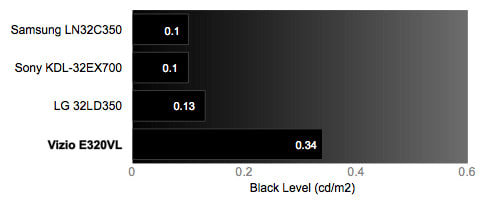
Peak Brightness
{{section_header}}{{section.name}}{{/section_header}}
Though not blindingly brilliant like the comparison models, the {{product.model}} displayed a peak brightness fit for any room in the house, during any time of day. More on how we test peak brightness.
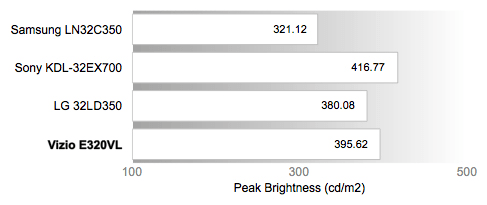
Contrast
{{section_header}}{{section.name}}{{/section_header}}
Holy contrast ratio Batman! 12000:1 is actually incredible, meaning not possible for this small, low-ender. You get Contrast ratio by dividing peak brightness by the deepest black. We know that the deepest black was artificially achieved by dimming the backlight and the resulting contrast ratio is based on this recording. We could not document the black level you would experience during playback, or contrast ratio for that matter, as the backlight dimming cannot be turned off.
Essentially, the {{product.model}} has a contrast ratio of 12000:1 only in transition from all-black screen to something else. You will never see this fantastic range when watching actual content, as the picture will either be wholly dimmed to get the low black level, or not dimmed at all for the peak brightness. Neither will work simultaneously to truthfully achieve a 12000:1 contrast ratio. More on how we test contrast.

Tunnel Contrast
{{section_header}}{{section.name}}{{/section_header}}
Theoretically, a small rectangle of pure black should be displayed at the same darkness as a large rectangle of pure black on a television screen. We test to see how each television matches up to this ideal with our Tunnel Contrast test, whereby we increase the area of a black rectangle and measure changes in luminance.
The chart below proves that there is some automatic backlight dimming happening on the {{product.name}}. As the rectangle got bigger, the black level dropped like a bad phone connection. You can see that right around 0.8 black (an 80% black screen), the brightness bottoms out at 0.02 where we recorded the black level. Just before this mark, where most content will fall,the {{product.model}}'s black level is much brighter. More on how we test tunnel contrast.
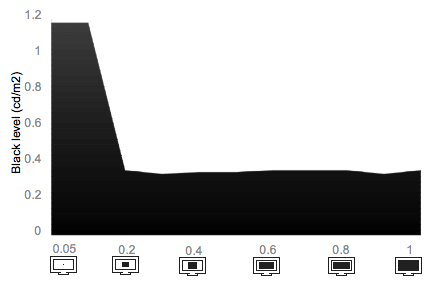
White Falloff
{{section_header}}{{section.name}}{{/section_header}}
The White Falloff test is similar to the Tunnel Contrast test. Instead of black rectangles, we use white ones on a black background to see if changing the area of white will effect the brightness produced by the {{product.name}}. What you see in the chart is a mostly unaffected peak brightness with changes of white areas. Although again, right around 0.2 (20% white screen, or an 80% black screen really) the backlight adjustor kicks in, not only affecting the black level, but drastically diminishing the peak brightness as well. More on how we test white falloff.
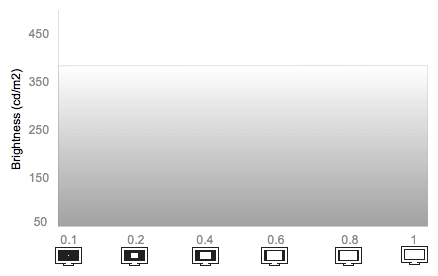
Uniformity
Greyscale Gamma
{{section_header}}{{section.name}}{{/section_header}}
After about middle grey, the graph of the grey scale looks great. It transitions smoothly, from one value to the next, with a slope similar to ideal. Just before this, in the darker end of the spectrum, the line curves sharply down and gets a little wiggly. The downward curve means the grey values on the {{product.model}} get dark faster than the signal does. The darkest grey values will smash together and lose detail, affecting shadows and dark pictures. The jumps in the line show that the {{product.model}} had trouble producing certain values sent by the signal, further obscuring detail in dark areas. The dark end of the spectrum on the {{product.name}} is a wash of black and is even more undecipherable than what is in the chart below, considering we know the entire screen dims itself at these values as well. More on how we test greyscale gamma.
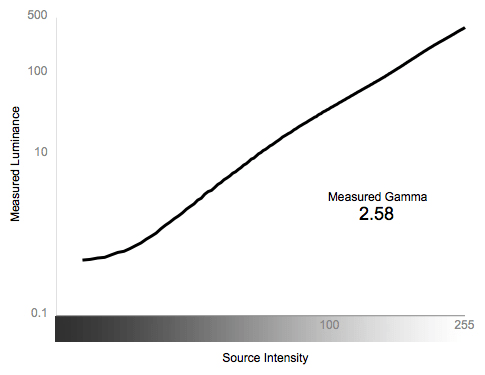
Color Temperature
{{section_header}}{{section.name}}{{/section_header}}
Color temperature on the {{product.name}} was strong, only noticeably straying outside the expected level a couple of times at the dark end of the spectrum. These deviations are not that drastic, but you may notice a slight blueish glaze to shadowy images. More on how we test color temperature.

RGB Curves
{{section_header}}{{section.name}}{{/section_header}}
These color curves are all wrong. What you are supposed to see, is three smooth lines, slightly, yet consistently curved, reaching from 0 to 100% luminance with no flat lining. Flat lines, at the beginning and end of this chart, are indicative of peaking and bottoming. Peaking means that after a certain point, the {{product.name}} cannot make colors any brighter. The brightest colors, specifically red and blue values, will be represented as planes of color, lacking detail imperative to describing a three dimensional object. Bottoming is the reverse of peaking, and you will lose detail in all of the dark colors, like anything in shadow.
The red values are clearly the biggest offenders, starting out flat (i.e. undifferentiated), jumping up suddenly into oversaturation, leveling off a little in the middle when they should be consistent along a gradient, and then peaking way too early. We tried our best, but there were no settings we could change that would affect them enough to make a difference. Detail and consistency of red values were lost far before we turned this TV on. More on how we test RGB curves.

The sections of color below are visual depictions of the RGB curves above. Looking at the beginning of the red strip for the {{product.name}}, you can clearly see a block of unchanging color showing you what peaking looks like. Compare that to the ideal response and you get a sense of the detail you lose on the {{product.model}}.
Motion Performance
{{section_header}}{{section.name}}{{/section_header}}
The {{product.name}} passed our motion tests, showing an average amount of detail loss and artifacting. Moving objects added some color trailing, judder and line skewing to the original signal. Line skewing has been a common problem for Samsung models this year, most probably due to a slow processor or low refresh rate that cannot change each row of pixels in unison. Line skewing became more obvious as the velocity of the object increased.
Televisions we test today often have some type of motion interpolation processing, creating frames between frames to enhance the refresh rate. Motion processing helps greatly with our motion tests, but can look a little strange with film or film-based content. The {{product.model}} is an entry-level model for Samsung and has no motion processing capabilities to beat these tests. More on how we test motion performance.
3:2 Pulldown & 24fps
{{section_header}}{{section.name}}{{/section_header}}
The {{product.name}} handled 24fps content easily with the built-in Film Mode. Films are still shot at 24fps. When they are translated to video, they are converted to 30fps in a complicated process called 3:2 pulldown. Blu-ray discs try to give you the original content as it was meant to be viewed and often come to you at 24fps, giving the content a very filmic look, as the director intended.
Film Mode, set on Auto 2, can detect and accurately display 24fps content on the 60Hz screen of the {{product.model}}. Even so, there was some judder on slow camera pans, but nothing too serious. More on how we test 3:2 pulldown and 24fps.
Resolution Scaling
{{section_header}}{{section.name}}{{/section_header}}
The {{product.name}} is deemed a 720p television because it has a resolution close to the NTSC standard of 1280 x 720 pixels. The actual resolution on the {{product.model}} is 1366 x 768, a left-over from computer monitor sizing. Well, this just won't work out because the standard signal - the one every content creator produces to - is not a 1:1 pixel match with the {{product.name}}. To compensate, the {{product.model}} is going to stretch the picture to fit its few extra pixels creating scanning problems. Overscan or underscan will produce artifacts in the picture like extra signal noise and banding in high frequency patterns.
We programmed our video card to send out a 1366 x 768 signal to the {{product.model}} and the result was a perfectly crisp picture with no scanning issues. Set to 720p, its supposed native resolution, the picture was noticeably worse: blurred edges and banding in moiré patterns.
Any NTSC standard format will be difficult to display accurately because they scale exactly, for example 720 to 1080 scales 1.5:1 easily, whereas 768 to 1080 scales at 1.40625:1, which gets a little more complex. When tested, we saw these problems with our own eyes. More on how we test resolution scaling.
480p
Changing the resolution to 480p also changes the aspect ratio from 16:9 to 4:3. Thus, the {{product.name}} showed 3% vertical and 2% horizontal overscan, but handled our moiré patterns the best at this resolution. There is significantly less data to display at 480p resolution which helped the {{product.model}} show fine distinctions in detail and text to be very legible.
720p
There should not be problems with high frequency patterns in a television's native resolution. Although, as we have stated before, 720p is not exactly the native resolution on the {{product.name}}. As such, there were significant banding problems in our moiré and fine detail patterns. There is nothing to do about this unless you can get your cable box or DVD player to convert to a 768x1366 signal.
1080p
1080p was a trying adventure for the {{product.name}}. There was no overscan at this resolution, but we knew the 1080x1920 pixel matrix would not map easily to the 768x1366 display on the {{product.model}} and that there would be inconsistencies with the signal.
Our moiré patterns were a mess. Instead of clean, thin, parallel lines, we saw lines banded together in strips in most of the patterns. Fine details were indistinguishable from one another in our resolution patterns. If you are watching content at 1080p, you will notice interference on heavily patterned clothes, and objects with intricate detail will be blurry. Text was the least legible at this resolution, but not too bad.
Formats
{{section_header}}{{section.name}}{{/section_header}}
The {{product.name}} displays at 720p (1360 x 768) and supports all standard NTSC formats, though not easily. If you refer back to the resolution scaling section, you can see how the difference in pixels will cause problems with NTSC format signals.
Viewing Angle
{{section_header}}{{section.name}}{{/section_header}}
The {{product.name}} showed a wide viewing angle for an LCD screen, especially compared to the similar models in the chart below.

Reflectance
{{section_header}}{{section.name}}{{/section_header}}
The screen on the {{product.name}} is highly reflective. Lights shined at the display were reflected back as a diffuse glow that hampered the contrast ratio of the entire picture from many angles. Furthermore, the reflected glow showed no signs of refracting the light into fewer colors to be less distracting.
Video Processing
{{section_header}}{{section.name}}{{/section_header}}
There are a couple of video processing modes for the {{product.name}} and we detail them below.
Calibration
{{section_header}}{{section.name}}{{/section_header}}
In the table below, you can find how we calibrated the {{product.name}}, using DisplayMate software for the best visual performance.

All of our calibration is done in conjunction with the DisplayMate software.
](http://www.displaymate.com/)
Video Modes
{{section_header}}{{section.name}}{{/section_header}}
There are just a few video modes on the {{product.name}} describing vaguely broad ranges of use. Thankfully, you can make changes to these modes in Picture Settings to adjust to the complexities of your environment.
Connectivity
{{section_header}}{{section.name}}{{/section_header}}
This little Samsung has the least amount of ports possible to be considered a real TV. There is one shared analog port, a half-hearted USB port, two HDMI ports, and that's it. There is no audio out of any kind, so do not expect to be able to connect this model to external speakers. With so few connections, you should strongly consider how you would be using this television before you buy.

Placement
{{section_header}}{{section.name}}{{/section_header}}
The ports were a little spread about on the back side of the {{product.name}} with little thought to organization. The stand is stationary, so you will have to lift all 9.7lbs of TV to connect, at most, three devices.
Audio Quality
{{section_header}}{{section.name}}{{/section_header}}
The {{product.name}} has a generally mediocre audio performance, though we didn't expect much from the two 5-watt speakers. There are plenty of options in the menu to tweak the quality of the tone, but there's only so much you can do with the limited hardware. There's simply no bass response. Fortunately, the TV doesn't even try to hit those tones, unlike many under-par TVs that create a scratchy rumble where the bass should be.
In the menu, you'll find a number of one-touch audio modes, a 5-channel equalizer, and a feature called SRS TruSurroundHD. We recommend you enable this feature, as it makes the dynamic range a little wider. If disabled, the speakers sound pretty terrible.
Menu Interface
{{section_header}}{{section.name}}{{/section_header}}
The {{product.name}} has a great menu system, as we've seen with every Samsung for the last couple years. What we appreciate so much is the clarity of the navigation. You always know where you are. Also, the categorization makes sense, for the most part, so if you go looking for a setting you'll probably find it right away.

Coupled with the easy to use remote control, you should have problems interacting with your TV. There are handy Return and Exit buttons, should you get lost.

Instruction Manual
{{section_header}}{{section.name}}{{/section_header}}
A thin paper instruction manual ships with the {{product.name}}, and there's a digital version you can download as a PDF here. The manual contains a fairly satisfactory explanation of each setting, though you'll always have to experiment to see which features are most useful to you (we recommend you disable most special processing features). Unlike some more expensive Samsung TVs, the manual is not loaded electronically into the TV. Don't worry, you're not missing anything with the omission of that feature.

A manual for so many TV models, they have to be further categorized by type.
Local Media Playback
{{section_header}}{{section.name}}{{/section_header}}
The {{product.name}} is marketed as having ConnectShare JPEG technology, that allows you to "easily connect your MP3 player or digital camera to your TV and share music, videos and photos. Simply connect your digital devices and enjoy." (according to the official Samsung specs sheet for the {{product.model}}) We tested this claim, finding it to be weak at best. To begin, the {{product.model}} does not support video playback, so scratch that.
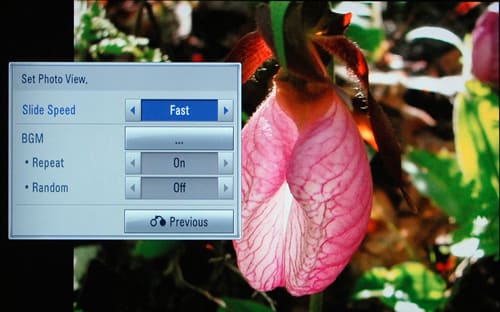
We connected both an iPod, the most popular MP3 player, and an iPhone, the most popular iPod, and had no luck playing songs or displaying pictures with either. We saw lists of folders, none of which had media in them.
We believe the problem is that the {{product.name}} only supports playback of JPEG and MP3 files, two formats that are becoming less popular. MP3 is a low-quality audio format that is being replaced by M4A files. If you download a song from iTunes or Amazon, you will generally get an M4A file. JPEGs are a compressed photo format, and few digital cameras will output directly to JPEG. It is unlikely that connecting your digital camera directly to the {{product.model}} will yield success.
This USB port is more for show (in the store that is) than for function.
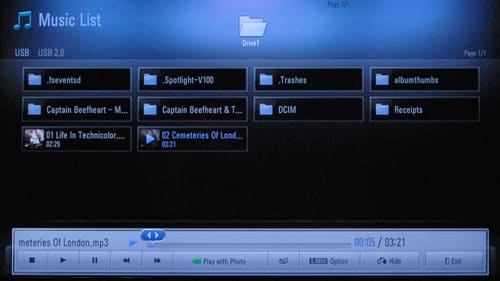
Power Consumption
{{section_header}}{{section.name}}{{/section_header}}
The {{product.name}} is a remarkably power efficient television, though it comes as no surprise to us. The screen size is small and the LED backlighting uses less power than older CCFL backlighting technology. There are additional power saving features in the menu, but it appears to be the same effect as simply turning down the Backlight setting, which you can do on any LCD television.
As you can see, the {{product.name}} compares favorably to the competition. Some of this is a natural result of the smaller screen size, but if you make some estimates in scaling up the size, it's still quite good.
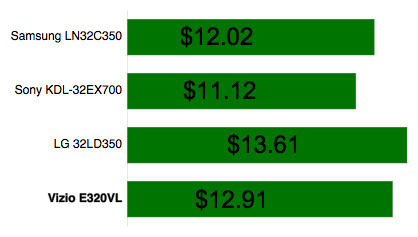
Value Comparison
{{section_header}}{{section.name}}{{/section_header}}
The UN32D4000 is one level up from the {{product.model}} on the Samsung chain of televisions. You get a few more ports, better color performance, but a significantly worse viewing angle for the extra $150 (approximately). Depending on what you are looking for, the {{product.model}} could satisfy what you need for a lower price.
Blacks & Whites
{{section_header}}{{section.name}}{{/section_header}}
Samsung is a crafty company, figuring out how to make these two LCD screens appear to have black level as dark as a plasma screen. From our tests in this review, we discerned that the {{product.model}} dimmed its entire picture, in situations of large sections of black, to seem to have an astronomical contrast ratio. When we tested the other Samsung model, the UN32D4000, we saw that a signal of dark grey to pure black dropped down the luminance scale drastically. The shadow values were crushed, meaning that shadows would be very dark, but have little detail from one value to the next.
Neither of these two sets is telling the whole truth exactly. The UN32D4000 is the lesser of the two evils because it does not dim the entire screen, rather it just darkens the black values beyond distinction. The contrast ratio on the UN32D4000 is more believable and will therefore yield a better range of light against dark.

Color Accuracy
{{section_header}}{{section.name}}{{/section_header}}
The {{product.model}} had a near perfect color temperature where the UN32D4000 had a real hard time staying level-headed, wandering far into the warm about mid-way through the gamut. But the colors on the UN32D4000 were more accurate and had a much larger range for greater color distinction. The UN32D4000 is the way to go here.
Motion
{{section_header}}{{section.name}}{{/section_header}}
These two Samsungs contain the same motion processing power and features. They performed identically on our motion tests.
Viewing Effects
{{section_header}}{{section.name}}{{/section_header}}
The UND324000 had a hard time with viewing angle, which is consistent with most Samsung models. The {{product.model}} had a surprisingly wide viewing angle, especially for an LCD.
Connectivity
{{section_header}}{{section.name}}{{/section_header}}
Both of these Samsungs could be considered minimalist when it comes to connections, but the UN32D4000 has more. The UN32D4000 has enough ports to be considered a stripped down TV, whereas the {{product.model}} is more like a computer monitor with one or two ports added.
Value Comparison
{{section_header}}{{section.name}}{{/section_header}}
Neither of these televisions are destined for greatness, but they both serve the purpose of a small, cheapish, extra TV. They performed so similarly that the important choices are how many ports you need and aesthetic value. They are priced similarly, the VIZIO being more expensive with a few more options but a worse viewing angle.
Blacks & Whites
{{section_header}}{{section.name}}{{/section_header}}
The VIZIO E320VP had a black level that was too bright for a strong contrast ratio. The range of light and dark values used to make fine value distinctions was not very broad on this VIZIO, and the resulting contrast ratio says it outright.
Though the {{product.name}} gave us a false reading to yield the contrast ratio you see below, the black level on a mostly white screen was lower than the VIZIO's in general.

Color Accuracy
{{section_header}}{{section.name}}{{/section_header}}
Where the {{product.name}} was near perfect in color temperature, the VIZIO E320VP was mostly wrong. You can see that the VIZIO is perceptibly cool for most signal intensities, from white to black.
The RGB curves on both of these TVs were inaccurate, showing some peaking, or near peaking in the case of the VIZIO. Neither are great, but the {{product.name}} is just so wrong that we have to give the win to the VIZIO by default.
Motion
{{section_header}}{{section.name}}{{/section_header}}
This VIZIO and the {{product.name}} performed in line with the average on our motion tests, showing the same artifacting problems with skewing and stair-stepping on the edges of objects. These problems were slightly less visible on the VIZIO.
Viewing Effects
{{section_header}}{{section.name}}{{/section_header}}
The VIZIO had a mediocre viewing angle for an LCD TV, where the {{product.name}} showed above average performance on the same type of screen.
Connectivity
{{section_header}}{{section.name}}{{/section_header}}
The VIZIO has more types of connections, specifically more variable with audio ins and outs: a headphone jack, a 1/8 inch audio in, and digital audio out for external speakers. The {{product.name}} has only a couple of connections and no audio out to improve upon the 5W speakers.
Value Comparison
{{section_header}}{{section.name}}{{/section_header}}
The LG 37LK450 gives its owner great all-around visual performance and 37 inches of screen for a great price. That is a hard package to beat, and the {{product.name}} is not the one to do it.
Blacks & Whites
{{section_header}}{{section.name}}{{/section_header}}
This LG had an average black level reading for an LCD screen. At 0.31 cd/m2, it did not get all that dark, but with a great peak brightness the LG was able to provide a strong contrast ratio.
This is a difficult comparison between these two sets. Given a fair reading, with no dimming, the {{product.name}} would not have a 12000:1 ratio, but would the actual value be greater or lesser than the LG? It is hard to say, but the LG gave a great range for an LCD television, that we know for sure.

Color Accuracy
{{section_header}}{{section.name}}{{/section_header}}
The LG in this comparison had better color accuracy than the {{product.name}}, with a well matched color gamut and beautiful color curves. The weakness of the LG 37LK450 was with color temperature, where from middle gray to deepest black, the picture will be blue enough to notice it's not correct.
Motion
{{section_header}}{{section.name}}{{/section_header}}
This LG was a top-performer on our motion tests, showing no warping or line skewing with moving objects. This means that the processor was powerful enough to refresh pixel rows fast enough to appear uniform. The {{product.name}} had trouble with this specifically. The two sets shared some artifacting problems such as juddering and edge flickering.
Viewing Effects
{{section_header}}{{section.name}}{{/section_header}}
These two had very similar viewing angles; strong for LCDs. The {{product.name}} edged the LG slightly in this comparison.
Connectivity
{{section_header}}{{section.name}}{{/section_header}}
You get the same number of HDMI ports on these TVs, but the LG has audio connections and way more analog ports to connect older devices and some gaming systems. Also, the LG has two types of computer connections, a VGA connection to mirror displays and an RS-232C port to run your television from an external computer.
Other Comparisons
{{section_header}}{{section.name}}{{/section_header}}
This LG has a facade partially covered in faux-wood paneling, just so you know. The {{product.name}} looks like a normal TV.
Conclusion
The {{product.name}} ($350 MSRP) is a small, entry-level set from Samsung, intended as a secondary TV for a bedroom or the kitchen. In this role, it will perform its job, but there are many drawbacks to consider before making that impulse buy.
As a secondary television, the {{product.model}} is a good fit for anywhere in the home or office. This handsome TV is pint-sized for close quarters, with a peak brightness that won't be affected by external light sources, and a wide viewing angle for an LCD screen. The color temperature will stay steady, but the colors themselves are unsatisfying.
Color performance is but one item on a list of cons for the {{product.model}}. The nonstandard screen resolution will cause problems with every signal intended to be viewed on a television, showing difficulty with any type of fine detail. There are so few connections in back of this device, that we would like to say that this is not a television for the dorm room. The set of colors on display were not wholly accurate, and they were crushed into a sadly narrow range, demonstrating poor detail and distinction at both ends of the luminance spectrum.
This TV is primarily cheap and slim, which may be the only points you need to know. There are better models for similar prices, even in the 2011 Samsung line. Though this is to be a secondary television, you can get better performance, variability and therefore longevity, out of something else.
Model Series Comparison
{{section_header}}{{section.name}}{{/section_header}}
The Samsung D4003 series is designed for the second bedroom, kitchen, garage, office, or any place where you don't need a dedicated entertainment hub. The screen sizes are quite small (19, 26, and 32 inches) and the connectivity is fairly limited. Factor in the 720p resolution and you can tell this is not aimed at the cinephile. While the performance certainly didn't wow us, it was adequate for its purposes.
Photo Gallery
{{photo_gallery "Front Tour Image", "Back Tour Image", "Sides Tour Image", "Stand Photo", "Controls Photo", "Remote Control Photo", "Connectivity Tour Image 1", "Connectivity Tour Image 2", "Connectivity Extra Photo", "Menu Main Photo", "Menu 2 Photo", "Internet Features 1 Photo", "Internet Features 2 Photo", "Internet Features 3 Photo", "Local Media Playback 1 Photo", "Local Media Playback 2 Photo"}}
Ratings & Specs
{{manufacturer_specs_table}}
Meet the tester
Christian Sherden is a valued contributor to the Reviewed.com family of sites.
Checking our work.
Our team is here to help you buy the best stuff and love what you own. Our writers, editors, and experts obsess over the products we cover to make sure you're confident and satisfied. Have a different opinion about something we recommend? Email us and we'll compare notes.
Shoot us an email